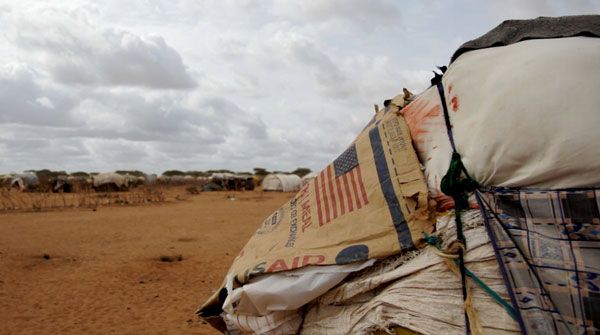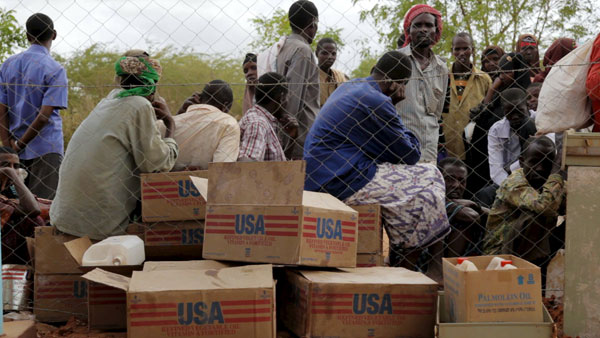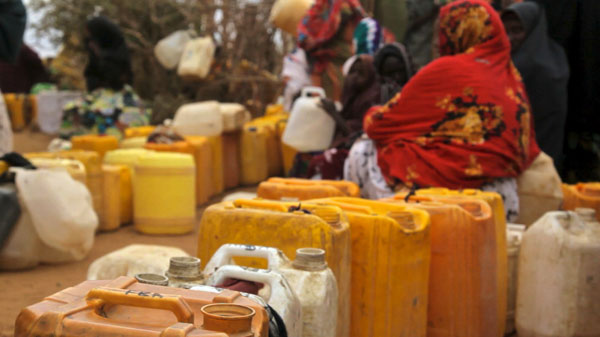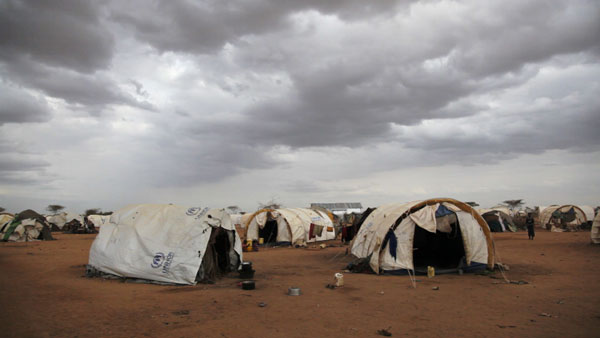In the fall of last year, the landscape of the Dadaab refugee complex, about fifty miles from Kenya’s border with Somalia, began to change dramatically. Slipshod tents built from scavenged plant matter and windblown detritus started springing up amongst the acacia trees that dot the arid plains of northeastern Kenya.
Dadaab’s boundaries had been swelling for years, but never so far out, nor so quickly. It started at Dagahaley, one of the three original camps that make up the complex, and then at a second camp, Ifo. With no more designated land to give to arriving refugees—plots had run out in 2008—unauthorized camps, referred to grimly as “the outskirts,” appeared beyond the official sites. The white tarpaulin tents of the United Nations High Commissioner for Refugees (UNHCR) gave way to motley hemispherical huts: loose twigs braided together into giant tumbleweeds and draped with old clothing, burlap and scraps of trash.
By February of this year, another ad hoc settlement was spreading, outside of the third camp, Hagadera. The monthly arrival rate at Dadaab had climbed by then from somewhere between 6,000 and 8,000 people, to about 10,000. And the settlements kept growing.
By the time famine was declared in two regions of Somalia on July 20—another three regions were deemed certifiably famished in early August—the monthly rate had tripled: at least 30,000 more refugees had arrived between June and July, roughly the number of people each camp was designed to shelter when they were first established in 1991. Now, around 440,000 people live in this camp built for 90,000. Visiting Dadaab makes one thing plain: this crisis did not just “strike” Somalia, contrary to what the headlines exclaim.
“Our animals died, and we have had no rain, to farm, for two years,” Hussein Mohamed Siad told me at Ifo in June. He and his family had just arrived, walking from the embattled Gedo region of Somalia, where in February some 180 villages had already been abandoned because of the drought. It took them thirty-one days to reach Dadaab. “For the last twenty years we have had increasing war,” he said. “But for us, the main reason we run is drought.” He’d already lost most of his livestock when militiamen came to take the rest.
There is no question that governments and international agencies have been sluggish in their response to the drought in the Horn of Africa. Pledges of emergency aid started flowing in mid-July, but the gulf between escalating UN appeals and international donations suggest that both sides seriously underestimated the scope of the disaster. In Somalia, the most distressed and most challenging country to reach, the twenty-year-old civil war has meant even less emergency relief than its neighbors. This is not just due to Somali insecurity: a counterproductive international intervention has helped create the conditions for the crisis, and is now impeding the response. (Over the same period, globalized economic policies have opened the region to agricultural markets while stifling subsistence agriculture—a larger trend underlying the famine that has received little honest discussion.)
Popular
"swipe left below to view more authors"Swipe →

Newly-arrived refugees set to building tents of scavenged debris and UN-supplied materials on the outskirts of Dadaab’s three refugee camps: Ifo, Dagahaley and Hagadera. More than 70,000 people now live outside of all three camps, although the UNHCR has begun transferring families to recently acquired land. Credit: Jacqueline Soohen/BIG NOISE FILMS
At the center of this intervention today is opposition to Somalia’s Al Qaeda–linked group, al-Shabaab, which has waged a relentless insurgency against Somalia’s Transitional Federal Government and its foreign supporters for the last five years—and which is now squarely taking the blame for aggravating the effects of the drought. There have been reports that local Shabaab groups have starved the people under their control, intercepting humanitarian assistance, controlling access to water sources and, most recently, holding captive those fleeing to camps in Mogadishu, Kenya and Ethiopia. In this southern half of the country, one of the most dangerous parts in the world for humanitarian workers, aid has long been scarce. Last year, many agencies had either suspended their operations in southern Somalia, or had been banned by al-Shabaab.
But the actions of al-Shabaab are only part of the story. In 2008, the last time the world rallied around a major food crisis in the region, the international community raised almost $2 billion in response. Almost half a billion dollars went to Somalia, 41 percent of which was given by the United States. That same year, the Bush administration officially declared al-Shabaab a terrorist organization, imposing financial sanctions spelled out in layers of counterterrorism legislation. Aid groups say these sanctions have virtually prevented US or US-funded agencies from operating in al-Shabaab controlled territory. Under the sanctions, local NGO partners or contractors could be found to be providing the group with “material support,” the parameters of which are only vaguely defined. The sanctions have also affected relationships with important local allies that NGOs spent years cultivating, says Sarah Margon, the associate director of the Sustainable Security and Peace Building Initiative at the Center for American Progress. “In some cases negotiations with local authorities—who might then be willing to negotiate with a local group of al-Shabaab—could have been possible,” she says. But with the sanctions, aid groups have worried that even indirect negotiations are too risky.

At a registration site at Dadaab refugee camp, refugees from Somalia recline on discarded food aid boxes, waiting for their turn to register and receive emergency rations. Many have walked for a month or more to arrive at the camp, located 50 miles south of the Kenya-Somalia border. Credit: Jacqueline Soohen/BIG NOISE FILMS
The Obama administration has strengthened sanctions targeting al-Shabaab as well as Somali pirate cartels. The overall effect has been a plummeting of US assistance to Somalia. In the past few years, the proportion of Somalia aid coming from the United States has hung closer to 10 percent of the global total. The United States went from giving $237 million in 2008, to $29 million in 2010. Since the declaration of the famine, US emergency support to the country has picked up slightly; Somalia has so far received just under $108 million, according to the UN Office for the Coordination of Humanitarian Affairs. This includes a $12 million contribution made on August 12. This is still a slim 18 percent slice of what the United States has donated to all four Horn of Africa countries, particularly to its counterterrorism allies Kenya and Ethiopia. Earlier this month, the Obama administration pledged an additional $105 million to East Africa. None of this aid appears to have been allocated directly to Somalia, according to data released by USAID, although some of it will go to Somali refugees and UNHCR operations.
“To the extent that Washington was interested in Somalia after 9/11, it was simply counterterrorism,” says David Shinn, a former ambassador to Ethiopia and Burkina Faso who currently teaches at George Washington University. “The Obama administration did not change dramatically. It has become more nuanced, but counterterrorism is still the predominant interest today.”

Somalis settled on the margins of the refugee camp must walk considerable distances to reach the nearest water pump, where they join scores of other people waiting to fill their jerry cans. Each person receives only fifteen gallons of water per day for drinking, cooking, cleaning, and watering livestock. This is far below the universal standard. Credit: Jacqueline Soohen/BIG NOISE FILMS
But the real problem is the deterioration of organizational infrastructure in recent years, which makes it almost impossible to get new aid to much of the country. With 3.7 million Somalis currently affected by the drought, the White House has tried to reassure aid groups that they can deliver assistance to Southern Somalia without fearing prosecution. But practically, this seems to amount to a legal buffer for the administration itself; aid groups complain that only projects funded or supervised by the US stand to receive real legal protections. “All we are asking is that they translate these verbal assurances—which are not legally binding—into something tangible,” says Jeremy Konyndyk, Director of Policy and Advocacy for Mercy Corps. Meanwhile, while experts say that the flight of aid groups from al-Shabaab territory is undermining the group’s political campaign, US sanctions don’t seem to have hurt its finances. The UN Security Council’s Monitoring Group on Somalia recently reported that al-Shabaab, which controls a large port in the city of Kismayo, profits hugely from the illegal import/export business. In 2010 the group pocketed more than $15 million in taxes from charcoal exports alone, and it makes up to $800,000 annually on sugar tariffs.
“We can now make the case more persuasively that food aid can go into Shabaab-controlled areas now, and it would not make a difference in the current struggle between the African Union and [Transitional Federal Government] troops, versus the Shabaab,” said Dr. Kenneth Menkhaus, a Somalia scholar who teaches at Davidson College.
Indeed, even if al-Shabaab commandeered some portion of the aid, it would arguably not be the most egregious waste of US funding. That the United States completely withdrew from Somalia after the disastrous “Blackhawk Down” incident in 1993 has become a popular trope for describing US policy towards the region. But this leaves out the fact that since 9/11, the United States has quietly lent its support to dubious local and regional actors it regarded as allies against an Islamic movement that it has always seen as a threat. These interventions by proxy have empowered the very forces the United States sought to quell, in large part because it has supported actors even more odious to Somalis than al-Shabaab. But US resources have also been hugely wasted by its recipients. The TFG—the latest attempt at a central Somali government and the current beneficiary of international support in southern and central Somalia apart from African Union forces—is proving to be no exception. It is intractably dysfunctional; corruption within the administration is profound. The latest Monitoring Group investigation suggests that large quantities of the TFG’s arsenal have found their way into the illicit arms market—and into the arsenal of al-Shabaab. More recently, the Somali government has barely acknowledged a massive diversion of food aid by businessmen in Mogadishu and official complicity (at least at the local level) seems likely).

Makeshift tents huddle on the outskirts of Dagahaley camp, beneath dark clouds that have not yielded rain in at least a year. Credit: Jacqueline Soohen/BIG NOISE FILMS
“If the TFG were doing anything but pocketing all the money that has been given to it, it would have a lot more resources than al-Shabaab,” said Menkhaus, a fact the US government is well aware of. Instead, Somali government officials complain of their impoverished counterinsurgency campaign, which has spent years wrestling Mogadishu back from the insurgency, block by bloody block. Army recruits are paid only sporadically.
On August 6, Shabaab forces suddenly withdrew from much of Mogadishu. While this news has generated tentative optimism, it may simply underscore the limitations of the current strategy. With the exception of the odd airstrike against terror suspects in the country, which seem to have done more damage to civilians than al-Shabaab, the United States continues to focus almost all attention on a limited counterinsurgency campaign in the capital, while remaining disengaged from the south-central regions outside of Mogadishu. Until now, this policy has done little but maintain conditions ripe for famine, and triggered a massive displacement of Somalis.
* * *
The hardship that awaits Somalis on the Kenyan side of the border has been underreported.
On the outskirts of Ifo in June, families sat under trees, looking shell-shocked. They had completed an incredible journey, possibly over one hundred miles, through desiccated territory overrun by militias. At a water pump, the only one around for a mile or so, a woman waited patiently for her turn. She was nervous about giving her name or having her photo taken, but said that life in the outskirts was scarcely safer than Mogadishu, which she had fled eight months before amidst heavy fighting. On the margins of Ifo she found herself defenseless amid new dangers, particularly the men who “wandered” the camp at night. According to the International Rescue Committee, sexual violence at the camp increased fourfold that month. Ifo’s refugees are also easy prey for the marauding bandits that roam such remote parts of Kenya, and rumors were flying about lion and hyena attacks.
Other threats—and the official response to them—are more insidious. The Kenyan government reports that Somali militants have used the camp to infiltrate the country and as a result, has refused to allow any investments in permanent infrastructure that might “attract” more refugees. The Spanish branch of Doctors Without Borders had plans to build a permanent hospital in Ifo but was forced to halt construction by the Kenyan government. So it set up a small clinic on the margins of the camp, mobile in the truest sense of the word: bands of tarp staked into the ground, demarcating rooms for treatment and assessment. It could be bundled up and moved out in under an hour.
Mortality rates were rising at Ifo in June. Most of the people at the clinic were suffering from malnutrition and its attendant miseries. A woman sitting quietly in the queue, like many of those around her, was of undeterminable age—her child was pint-sized, but her own skin was brittle and deeply lined. She had brought her son to the clinic because he was starving. While she spoke, her son shrieked for his mother as health workers weighed him in a hanging plastic bin tied to a scale, then transferred him to ruled surface to measure his bony frame. “Here at the camp we have a lot of problems,” said the woman, whose name was Halima. “The food we are getting now is very small. It’s not enough. It isn’t possible for me to feed my family.” Both Halima and her son were so frail, it was easy to assume they had just left Somalia. In fact, they had been at Ifo for about four months.
“We thought at some point that the situation would improve, but it did not,” said Fafa Attidzah, the head of the UNHCR’s Dadaab sub-office. “The congestion in the camp has brought about inadequacy in the delivering of service to people. The lack of space does not allow humanitarian agencies to provide the standard assistance.” It’s not that aid workers don’t understand the needs of refugees or haven’t planned for them, he said. “The initial plan that we had for the camps,” he explained, “is completely not respected anymore.”
Indeed, the UNHCR had longstanding plans to alleviate some of the overcrowding, via a fourth camp called “Ifo II,” designed to hold 80,000 people. The transfer of nearby land had been negotiated with local and national authorities two years before and construction was underway in 2010 to build 15,000 houses. But in October the Kenyan government about-faced. Citing “security concerns,” Nairobi decreed that no refugees would be transferred to the camp. In January of this year, as the failed fall rains drove more people into the camps, the government halted construction altogether. By then, the UNHCR had already spent $16 million on the project. The handling of Ifo II provides a glimpse of the kind of inefficiency and counterproductive policies that are undermining relief efforts every day. Days before the famine was officially declared, facing a PR nightmare, Kenyan Prime Minister Raila Odinga announced at a press conference that his government “[could not] turn away the refugees,” and that the camp would be open within ten days. With encouragement from both the government and the UNHCR, the media have since been reporting the transfer of refugees to “Ifo extension”—the overarching label given to Ifo II and yet another plot of land where Nairobi has authorized UNHCR tents, Ifo III—but aid workers at Dadaab say the original multimillion-dollar construction remains closed.
“My read is that they are just fed up,” said Attidzah in June. “They are saying, ‘We don’t want more refugees. We don’t want more of them, because of the instability that they can bring into Kenya.’” So 1,116 tidy mud-brick houses stand padlocked, along with new schools, a health clinic, and other facilities, while the dilapidated handmade settlements creep closer to it’s gates.
The protracted stalemate over Ifo II has not kept refugees from coming in. It has only pushed them into conditions that some say are worse than what they left behind and further aggravated the crisis at Dadaab, which was barely managing before. On a day in late June, the food distribution site in Ifo was enveloped in a cloud of dust after a riot broke out following a fight between a Kenyan police officer and a boy who had allegedly tried to flout the rules. The police reportedly beat the boy to the point of critical injury, and angry protesters had torn down parts of the entrance gate and taken some of the food before the situation was subdued. These incidents are still rare, say aid workers and refugees, but they are becoming more frequent as the camps become unbearably overcrowded. Earlier this month Kenyan police used live fire to subdue a more unruly demonstration, reportedly killing two people and injuring more.
The responses to these small conflagrations say something about the prevailing attitude towards containing the Somalia crisis: The bluntest means of maintaining security are often favored over more nuanced approaches toward long-term stability. Like the US, the Kenyan government has allowed counterterrorism concerns to dictate contradictory policy decisions that augur continued instability in the region. Convinced that its terrorism problem is, fundamentally, a refugee problem, the Kenyan government has recently drawn itself deeper into Somalia’s conflict, giving assistance to ambitious Somali politicians and militias trying to set up a dubious regional administration in the south, even recruiting refugees from Dadaab, with hopes this will facilitate the eventual return of refugees back into Somalia. But the country’s recent war-wracked history has been punctuated by disastrous interventions by foreign governments, leaving many Somalis rightfully hostile towards such schemes. A foreign-sponsored power struggle has little chance of success, warn analysts in and outside of Somalia, and stands to splinter a barely held-together alliance against the Shabaab.
“The famine may provoke a real rethink” on Somalia policy, said Menkhaus, the Davidson professor, noting that there are a few members of the current US administration truly committed to supporting political reconciliation in the country, that goes beyond keeping al-Shabaab at bay. But, he pointed out, “sustained engagement on Somalia has never advanced anyone’s career, in the UN or donor governments, because the failure rate has been so high.” If the war drags on, the exodus from Somalia will become irreversible, he fears, noting a pattern he has observed studying Somalia for the last twenty-five of its tumultuous years. “The real story here is that the situation in Somalia is bad enough that once Somalis move towards a border, they don’t go back.”


